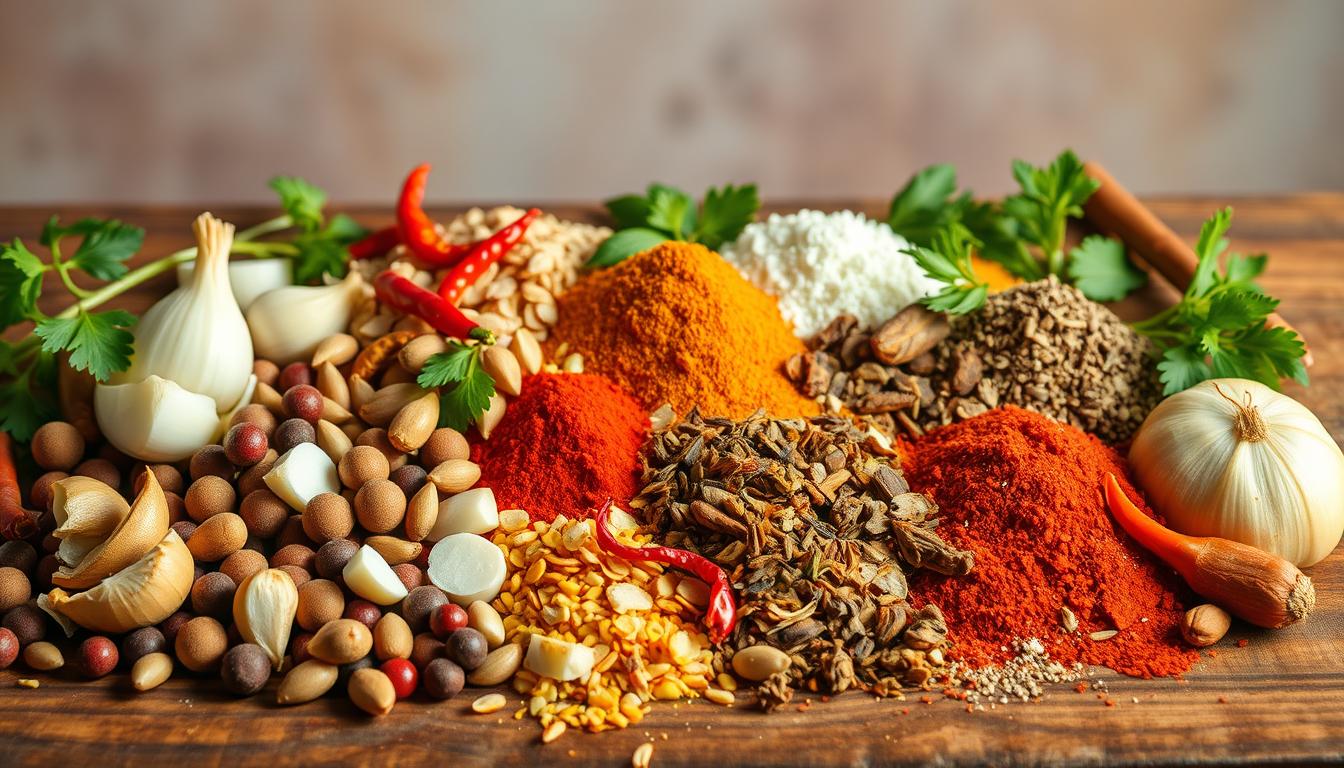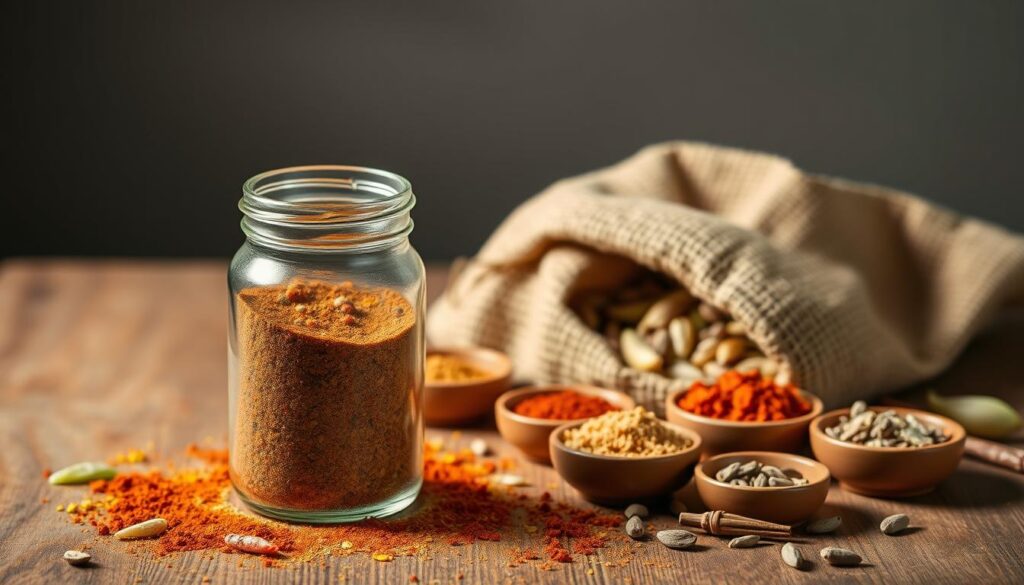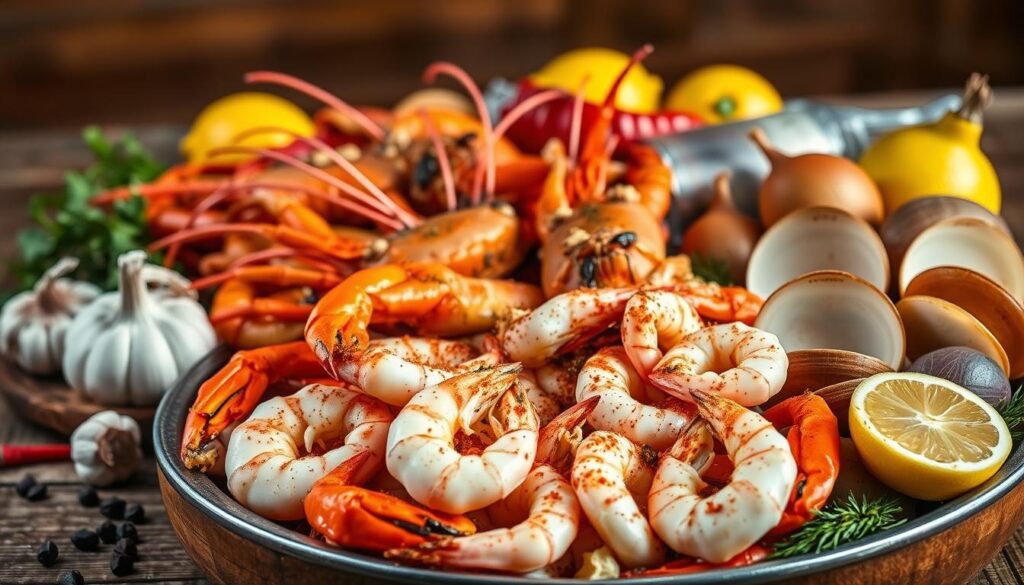
The smell of a well-seasoned seafood boil reminds us of summer, the sea, and family traditions. Making your own seafood seasoning is more than a recipe. It’s a journey that turns simple seafood into a memorable meal.
When you make your own seafood seasoning, you control the taste, heat, and ingredients. Whether it’s a Louisiana crawfish boil or a shrimp feast, your homemade seasoning makes it special.
Every part of the U.S. has its own seafood boil seasoning style. This shows off local tastes and cooking traditions. By making your own mix, you discover flavors that store-bought can’t match.
Understanding Seafood Boil Seasoning Basics
Starting a seafood boil is all about the seasoning. It’s a journey into the world of flavors that make these dishes special. You’ll learn about the southern-style seafood boil techniques.
Seafood boil seasonings are more than spices. They are a rich tradition that changes with each region and cooking style.
Essential Spice Components
A great cajun spice blend starts with key spices. These spices add depth and excitement to seafood dishes. The main ingredients are:
- Salt (primary flavor enhancer)
- Celery seed
- Mustard powder
- Red pepper flakes
- Black pepper
- Paprika
Traditional vs Modern Blends
Seafood spice blends have changed over time. Old bay seasoning shows this evolution. Traditional recipes used simple, local spices. Modern blends add global flavors and complex tastes.
| Traditional Blend | Modern Blend |
|---|---|
| Salt, pepper, paprika | Exotic spices, herb infusions |
| Limited ingredient list | Complex multi-layered flavors |
Regional Variations in Seasoning
Regions have their own seafood boil seasonings. The Gulf Coast likes spicier cajun blends. Chesapeake Bay areas prefer milder, more subtle old bay seasonings.
Your seafood boil seasoning tells a story. It’s about regional traditions and new flavors.
Key Ingredients for Perfect Seafood Boil Seasoning Recipe
Making a great seafood boil seasoning recipe is all about the right spices. It’s not just about adding heat. It’s about blending flavors that make your seafood taste amazing.
Start with the best ingredients for a top-notch seafood boil seasoning. Here’s what you need:
- Salt: The universal flavor enhancer
- Cayenne Pepper: Provides signature spicy kick
- Paprika: Adds vibrant color and mild sweetness
- Black Pepper: Introduces sharp, earthy undertones
- Garlic Powder: Infuses savory richness
- Bay Leaves: Contribute fragrant herbal notes
Each spice is important in your seafood boil seasoning. Cayenne pepper adds heat, while paprika brings a sweet touch. Garlic and onion powders make a strong base that enhances the seafood’s taste.
“The magic of a great seafood boil lies in the balance of its spices” – Coastal Cooking Wisdom
When making your cajun spice blend, think about different regional flavors. These can help you create your own special mix:
| Region | Signature Spice Characteristics |
|---|---|
| Louisiana | Extra cayenne, intense heat |
| Carolinas | Milder blend with celery seed |
| New England | Minimal seasoning, focusing on seafood’s natural flavor |
The best seafood boil seasoning recipe is yours to make. Feel free to try new things and adjust the spices to your liking!
The Perfect Spice Ratio and Measurements
Making the perfect seafood seasoning is all about precision and knowing how to balance flavors. Whether you’re making a shrimp boil or crab boil seasoning, the right amounts can make a huge difference. It can turn a simple dish into something truly special.
To create a great seafood seasoning blend, you need to measure three key parts: base seasonings, heat elements, and aromatic additions. Each part is important for creating a rich and complex flavor.
Base Seasonings
The base seasonings are the foundation of your seafood seasoning. They usually include:
- Sea salt (2 tablespoons)
- Black pepper (1 tablespoon)
- Paprika (1.5 tablespoons)
- Dried herbs (1 tablespoon)
Heat Elements
The heat elements add the spiciness to your shrimp boil seasoning. You can adjust these based on how spicy you like it:
- Cayenne pepper (1/2 to 1 teaspoon)
- Red pepper flakes (1 teaspoon)
- Chili powder (1/2 tablespoon)
Aromatic Additions
The aromatic ingredients add depth and complexity to your crab boil seasoning. They include:
- Garlic powder (1 tablespoon)
- Onion powder (1 tablespoon)
- Dried thyme (1 teaspoon)
- Celery seed (1/2 teaspoon)
| Ingredient Category | Key Components | Recommended Quantity |
|---|---|---|
| Base Seasonings | Sea Salt, Black Pepper | 2-3 tablespoons |
| Heat Elements | Cayenne, Red Pepper Flakes | 1/2-1 tablespoon |
| Aromatic Additions | Garlic, Onion Powder | 1-2 tablespoons |
Pro tip: Always taste and adjust your seafood seasoning blend to match your personal preference. Start with smaller quantities of spicy ingredients and gradually increase to find your perfect balance.
Step-by-Step Mixing Instructions
Making the perfect seafood boil seasoning recipe needs focus and the right mixing steps. Follow these steps to bring your homemade seasoning to life.
First, gather all your dry ingredients together. The secret to a great seafood boil seasoning is making sure spices are evenly spread.
- Choose a big mixing bowl for blending well
- Use standard tools to measure each spice accurately
- Sift powdered spices to avoid clumps
- Arrange ingredients in layers for better mixing
When mixing your homemade seasoning, use a whisk or spoon. Use gentle circular motions to mix well and keep flavors consistent.
| Mixing Technique | Recommended Action |
|---|---|
| Powder Spices | Sift before mixing |
| Whole Spices | Grind first, then incorporate |
| Mixing Duration | 3-5 minutes of consistent blending |
Pro tip: Taste your seasoning by sprinkling a bit on your palm. This helps adjust the flavor before packaging.
The secret to an incredible seafood seasoning is patience during the mixing process.
Keep your mixed seasoning in an airtight container. Store it away from sunlight and moisture to keep its flavors bright.
Storage and Shelf Life Tips
Keeping your homemade seafood boil seasoning recipe fresh is key. The right storage can make a big difference. It ensures your seasoning stays vibrant and flavorful, enhancing your seafood dishes.
Proper Container Selection
Choosing the right container is vital for your homemade seafood seasoning. Here are some top picks:
- Airtight glass jars with tight-sealing lids
- Ceramic containers with rubber gaskets
- Stainless steel containers with secure closures
Maintaining Flavor Potency
To keep your seasoning at its best, follow these storage tips:
- Store in a cool, dark pantry
- Avoid direct sunlight and heat sources
- Keep away from moisture and humidity
Signs of Seasoning Degradation
Knowing when to replace your seasoning is crucial. Look out for these signs:
| Indication | Action Required |
|---|---|
| Loss of vibrant color | Replace seasoning |
| Dull or flat aroma | Discard and remake |
| Clumping or moisture buildup | Immediately replace |
By using these storage tips, your homemade seafood seasoning will stay fresh. It will keep your seafood boils delicious and memorable.
Creating Custom Seafood Boil Variations

Making your own seafood boil seasoning is a fun journey. It lets you tailor flavors and try out new spice mixes. You might want to create a spicy Cajun blend or a classic Old Bay seasoning. The trick is to know how to mix and layer your spices right.
Begin by looking at flavors from different places that excite you. A Southern-style seafood boil often uses strong, bold seasonings. Here are some tips for making your own mix:
- Try changing the heat by adjusting cayenne and black pepper
- Add dried herbs like thyme or oregano for more depth
- Experiment with different salts – sea salt, kosher salt, or smoked salt
- Include dried citrus peels for a bright, complex taste
When making your special blend, remember that how much you use matters. Start with small batches to test and tweak your recipe. Different seafood types need different seasoning levels. A light touch is best for delicate fish, while shellfish can handle stronger flavors.
Pro tip: Keep a detailed journal of your experiments. Write down the exact amounts, ingredients, and your thoughts. This will help you make the same great blends again and keep improving your seafood boil seasoning.
How to Use Your Seasoning in a Boil
Mastering a seafood boil party is all about the right seasoning. Your homemade crab boil seasoning can make a shrimp boil unforgettable. The secret is in how you use it.
Water-to-Seasoning Ratios
For the best flavor, know the right water-to-seasoning mix. Here’s a guide for a tasty seafood boil:
- 1 pound of seasoning per 2 gallons of water
- For 8 quarts of water, use 1 cup of seasoning
- Adding a splash of beer can add depth to the flavor
Temperature and Timing Mastery
Perfect cooking needs the right temperature and timing:
- Boil seasoned liquid for 5 minutes to develop flavors
- Add potatoes and corn, cook 15 minutes
- Introduce sausage, simmer 5 minutes
- Add seafood, cook 5-7 minutes until shrimp turn pink
Seasoning Distribution Techniques
To get an even flavor profile, layer ingredients:
- Add seasoning to water first
- Start with potatoes and corn
- Follow with sausage
- Finish with seafood
Flavor Intensity Adjustment
| Flavor Intensity | Seasoning Amount |
|---|---|
| Mild | 1 tablespoon per pound |
| Medium | 1.5 tablespoons per pound |
| Bold | 2 tablespoons per pound |
For a great seafood boil party, experiment and find your seasoning balance. Start with a small amount and adjust to taste.
Pairing Your Seasoning with Different Seafood Types

Creating the perfect shrimp boil seasoning is all about knowing how seafood reacts to your spices. Each seafood type has its own special qualities that can make your crab boil seasoning even better.
When making crawfish boil spices, think about the delicate nature of different shellfish. Some need gentle seasoning, while others can handle strong, bold flavors.
- Shrimp: Needs lighter seasoning to keep its natural sweetness
- Crab: Does well with strong, complex spice mixes
- Crawfish: Loves Louisiana-style, spicy seasoning blends
Your homemade seafood boil seasoning can change based on the seafood you’re cooking. Delicate fish might need less spice, while strong shellfish can handle more.
Pro tip: Always taste your seasoning blend before adding seafood to ensure the right balance of heat and flavor.
Different cooking methods also affect how you use your seasoning. Grilling, steaming, or boiling each need slight spice adjustments.
Complementary Ingredients and Add-ins
To make your southern-style seafood boil stand out, you need more than just seasoned seafood. The right mix of ingredients can turn a simple meal into a memorable experience.
Classic add-ins are key to a flavorful seafood boil party. Here are some essential ingredients to elevate your boil:
- Corn on the Cob: Sweet corn takes in the rich seasoning, adding a burst of flavor
- Red Potatoes: They soak up the spices well, making them hearty and starchy
- Andouille Sausage: Adds a spicy Cajun flavor to the dish
- Whole Garlic Cloves: Give the boil an aromatic depth
- Fresh Lemon Wedges: Add a bright, citrusy contrast
When adding ingredients, timing is everything. Potatoes and corn need more time, while seafood cooks faster. Tip: Arrange your ingredients to cook evenly.
Want to try something new? Add unique ingredients like:
- Artichoke hearts
- Mushrooms
- Whole baby onions
- Cauliflower florets
The secret to a great seafood boil party is balancing flavors and textures. Your add-ins should complement the seafood, not overpower it.
Conclusion
Making your own seafood seasoning can turn simple meals into amazing dishes. By creating a unique blend, you can make your seafood boil parties unforgettable. This is something store-bought seasonings can’t do.
Creating your own seasoning is more than just mixing spices. It’s a journey of taste, creativity, and self-expression in the kitchen. Each blend you make tells a story, showing off your taste and adventurous spirit.
Your skills in seasoning will let you try new things and improve your recipes. Whether it’s a small family dinner or a big seafood boil party, your seasoning will be the highlight. Enjoy the process, trust your taste, and relish the tasty outcomes of your creativity.
Great cooking is about passion, trying new things, and sharing special moments with loved ones. Your homemade seasoning is more than a flavor enhancer. It’s a way to create unforgettable dining experiences that everyone will cherish.
FAQ
What is the difference between Cajun and Old Bay seasoning for seafood boils?
Cajun seasoning is spicier, with cayenne pepper, paprika, and garlic powder. Old Bay is milder, with herbs like celery salt and paprika. Cajun comes from Louisiana, while Old Bay is from Maryland.
How long can I store homemade seafood boil seasoning?
Store it in an airtight container, away from heat and sunlight. It lasts 3-6 months. For best flavor, use it within 3 months and keep it cool and dry.
Can I adjust the spice level in my seafood boil seasoning?
Yes! You can change the heat by adding more cayenne pepper or red pepper flakes. Start small and add more to taste. It’s easier to add heat than to take it away.
What types of seafood work best with a boil seasoning?
Seafood boil seasonings are great for shellfish like shrimp and crab. They also work well with firm fish like cod. Adjust the seasoning for different seafood to match their flavors.
Is it cheaper to make my own seafood boil seasoning?
Making your own is cheaper than buying it. Buying spices in bulk saves money. You can also control the quality and taste of your seasoning.
How do I know if my seasoning has gone bad?
Look for signs like color loss, clumping, or a dull smell. If it doesn’t smell fresh, it’s time for a new batch. Storing it in an airtight container helps keep it fresh longer.
Can I use this seasoning for methods other than boiling?
Yes! You can use it for grilling, baking, steaming, or as a dry rub. It adds flavor to many cooking methods, not just boiling.
Are there any allergen concerns with seafood boil seasoning?
Always check the spice ingredients for allergens. Some may have celery, mustard, or nuts. If you’re making it for others, tell them about the ingredients and any dietary restrictions.
Source Links
- https://aneasyrecipes.com/seafood-boil-seasoning-guide/
- https://www.recipemeat.com/seafood-boil-seasoning-recipe/
- https://www.tropicrecipes.com/seafood-boil-seasoning/
- https://www.momentsrecipes.com/how-to-prepare-a-perfect-seafood-boil-tips/
- https://www.chilipeppermadness.com/recipes/seafood-boil-seasoning/
- https://homediningkitchen.com/how-much-seasoning-do-you-put-in-crawfish-boil/

